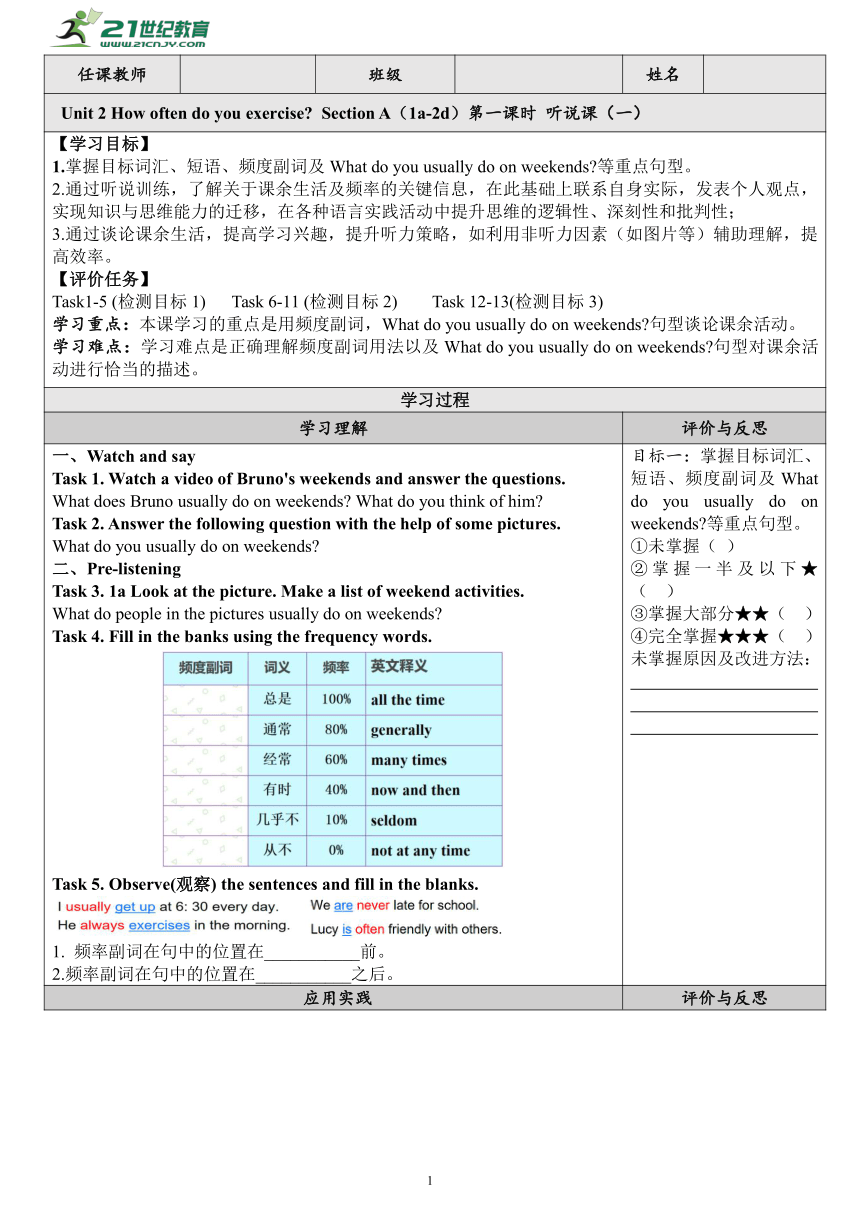Unit 2 How often do you exercise Section A(1a-2d)第一课时 听说课(一)学历案-2024秋人教八上
文档属性
| 名称 | Unit 2 How often do you exercise Section A(1a-2d)第一课时 听说课(一)学历案-2024秋人教八上 |

|
|
| 格式 | docx | ||
| 文件大小 | 344.6KB | ||
| 资源类型 | 试卷 | ||
| 版本资源 | 人教新目标(Go for it)版 | ||
| 科目 | 英语 | ||
| 更新时间 | 2024-09-14 09:12:50 | ||
图片预览

文档简介
任课教师 班级 姓名
Unit 2 How often do you exercise Section A(1a-2d)第一课时 听说课(一)
【学习目标】 1.掌握目标词汇、短语、频度副词及What do you usually do on weekends 等重点句型。 2.通过听说训练,了解关于课余生活及频率的关键信息,在此基础上联系自身实际,发表个人观点,实现知识与思维能力的迁移,在各种语言实践活动中提升思维的逻辑性、深刻性和批判性; 3.通过谈论课余生活,提高学习兴趣,提升听力策略,如利用非听力因素(如图片等)辅助理解,提高效率。 【评价任务】 Task1-5 (检测目标1) Task 6-11 (检测目标2) Task 12-13(检测目标3) 学习重点:本课学习的重点是用频度副词,What do you usually do on weekends 句型谈论课余活动。 学习难点:学习难点是正确理解频度副词用法以及What do you usually do on weekends 句型对课余活动进行恰当的描述。
学习过程
学习理解 评价与反思
一、Watch and say Task 1. Watch a video of Bruno's weekends and answer the questions. What does Bruno usually do on weekends What do you think of him Task 2. Answer the following question with the help of some pictures. What do you usually do on weekends 二、Pre-listening Task 3. 1a Look at the picture. Make a list of weekend activities. What do people in the pictures usually do on weekends Task 4. Fill in the banks using the frequency words. Task 5. Observe(观察) the sentences and fill in the blanks. 1. 频率副词在句中的位置在___________前。 2.频率副词在句中的位置在___________之后。 目标一:掌握目标词汇、短语、频度副词及What do you usually do on weekends 等重点句型。 ①未掌握( ) ②掌握一半及以下★( ) ③掌握大部分★★( ) ④完全掌握★★★( ) 未掌握原因及改进方法:
应用实践 评价与反思
三、While-listening Task 6. Do 1b.. 四、Post-listening Task 7. 1c Practice the conversation in the picture above. Then make your own conversations about what you do on weekends. Task 8. Watch the picture and guess. 1. What’s the boy’s name 2. What’s the women's job 3. What question is the woman asking 4. What is the boy answering Task 9. Listen and practice. (1)Finish 2a. (2)Finish 2b . Task 10. Match the English phrases with Chinese meaning.(活动见PPT) Task 11. 2d Finish the following activities. Read the conversation and match the activity with the right time. Role-play the conversation. Grammar points: new words, phrases and sentence patterns. New words Phrases(短语)Sentence patterns(句式结构)
目标二:通过听说训练,了解关于课余生活及频率的关键信息,在此基础上联系自身实际,发表个人观点. ①未掌握( ) ②掌握一半及以下★( ) ③掌握大部分★★( ) ④完全掌握★★★( ) 未掌握原因及改进方法:
迁移创新 评价与反思
Task 12. 2c How often do you do these activities Fill in the chart and then make conversations. Task 13. Give us a report about how often you do things. 例子:Let me tell you about how often I do things. I watch TV every day. My favorite program is Animal world. I watch it twice a week... 目标三:根据2c表格,然后向全班作报告。 ①未掌握( ) ②掌握一半及以下★( ) ③掌握大部分★★( ) ④完全掌握★★★( ) 未掌握原因及改进方法:
课后作业
完成第一课时的练习题。 抄写并翻译2d. 根据2c的例子,编写新的对话,并且仿照Task13 的例子一篇小短文。
Unit 2 How often do you exercise Section A(1a-2d)第一课时 听说课(一)
【学习目标】 1.掌握目标词汇、短语、频度副词及What do you usually do on weekends 等重点句型。 2.通过听说训练,了解关于课余生活及频率的关键信息,在此基础上联系自身实际,发表个人观点,实现知识与思维能力的迁移,在各种语言实践活动中提升思维的逻辑性、深刻性和批判性; 3.通过谈论课余生活,提高学习兴趣,提升听力策略,如利用非听力因素(如图片等)辅助理解,提高效率。 【评价任务】 Task1-5 (检测目标1) Task 6-11 (检测目标2) Task 12-13(检测目标3) 学习重点:本课学习的重点是用频度副词,What do you usually do on weekends 句型谈论课余活动。 学习难点:学习难点是正确理解频度副词用法以及What do you usually do on weekends 句型对课余活动进行恰当的描述。
学习过程
学习理解 评价与反思
一、Watch and say Task 1. Watch a video of Bruno's weekends and answer the questions. What does Bruno usually do on weekends What do you think of him Task 2. Answer the following question with the help of some pictures. What do you usually do on weekends 二、Pre-listening Task 3. 1a Look at the picture. Make a list of weekend activities. What do people in the pictures usually do on weekends Task 4. Fill in the banks using the frequency words. Task 5. Observe(观察) the sentences and fill in the blanks. 1. 频率副词在句中的位置在___________前。 2.频率副词在句中的位置在___________之后。 目标一:掌握目标词汇、短语、频度副词及What do you usually do on weekends 等重点句型。 ①未掌握( ) ②掌握一半及以下★( ) ③掌握大部分★★( ) ④完全掌握★★★( ) 未掌握原因及改进方法:
应用实践 评价与反思
三、While-listening Task 6. Do 1b.. 四、Post-listening Task 7. 1c Practice the conversation in the picture above. Then make your own conversations about what you do on weekends. Task 8. Watch the picture and guess. 1. What’s the boy’s name 2. What’s the women's job 3. What question is the woman asking 4. What is the boy answering Task 9. Listen and practice. (1)Finish 2a. (2)Finish 2b . Task 10. Match the English phrases with Chinese meaning.(活动见PPT) Task 11. 2d Finish the following activities. Read the conversation and match the activity with the right time. Role-play the conversation. Grammar points: new words, phrases and sentence patterns. New words Phrases(短语)Sentence patterns(句式结构)
目标二:通过听说训练,了解关于课余生活及频率的关键信息,在此基础上联系自身实际,发表个人观点. ①未掌握( ) ②掌握一半及以下★( ) ③掌握大部分★★( ) ④完全掌握★★★( ) 未掌握原因及改进方法:
迁移创新 评价与反思
Task 12. 2c How often do you do these activities Fill in the chart and then make conversations. Task 13. Give us a report about how often you do things. 例子:Let me tell you about how often I do things. I watch TV every day. My favorite program is Animal world. I watch it twice a week... 目标三:根据2c表格,然后向全班作报告。 ①未掌握( ) ②掌握一半及以下★( ) ③掌握大部分★★( ) ④完全掌握★★★( ) 未掌握原因及改进方法:
课后作业
完成第一课时的练习题。 抄写并翻译2d. 根据2c的例子,编写新的对话,并且仿照Task13 的例子一篇小短文。
同课章节目录
- Unit 1 Where did you go on vacation?
- Section A
- Section B
- Unit 2 How often do you exercise?
- Section A
- Section B
- Unit 3 I'm more outgoing than my sister.
- Section A
- Section B
- Unit 4 What's the best movie theater?
- Section A
- Section B
- Unit 5 Do you want to watch a game show?
- Section A
- Section B
- Unit 6 I'm going to study computer science.
- Section A
- Section B
- Unit 7 Will people have robots?
- Section A
- Section B
- Unit 8 How do you make a banana milk shake?
- Section A
- Section B
- Unit 9 Can you come to my party?
- Section A
- Section B
- Unit 10 If you go to the party, you'll have a grea
- Section A
- Section B
